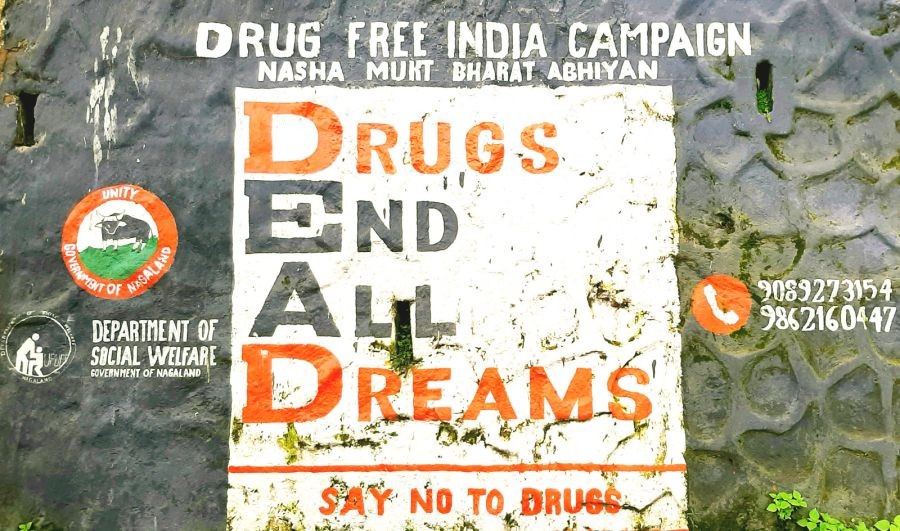An anti-drug wall art slogan in Kohima reads ‘DRUGS END ALL DREAMS; SAY NO TO DRUGS.’ (Morung Photo)

Atono Tsükrü Kense
Kohima | June 25
Substance abuse among women might be more prevalent than one might think, if information from substance users’ community is any indication.
Although there is no official documentation till date, it was learnt that there are about 30-40 female injecting drug users in Kohima alone, in the age group of 20-30 years.
Speaking to The Morung Express, Ketho Angami from the ARK Foundation noted: “We are looking at a scenario where there is a prevalence of women who inject drugs which was unheard of for 17-18 years.”
Describing the present substance use, especially among the young adolescents and females, as “hidden and unreached population,” he maintained that with the wide availability of new and varied drugs in the streets, young adolescents including females and many others are getting introduced into the habit.
Nonetheless, men and women face diverse unique issues when it comes to substance use, due in part to stereotyping of gender roles.
“Women who use drugs are more vulnerable as they face multiple stigmatisation and discrimination than their counterparts,” Ketho stated.
Besides, women are more vulnerable to exploitation in terms of their rights, dignity, violence and abuse, and face greater risk for HIV, viral hepatitis and other sexually transmitted diseases, he added.
Although, substance abuse is still plaguing the society, Ketho viewed that people do not talk about it anymore unlike in the past when substance use was rampant.
This, he observed, was due to the fact that the system of procuring and exchange of drugs have drastically changed due to technology.
“Those days, people loiter around the town waiting, but these days with technology everything is done away from the prying eyes of people,” he pointed out adding, perhaps, this is why people choose to ignore and remain oblivious with the ground reality.
‘Too much a burden to carry’
“The tag attached to a woman who uses drugs stays forever as it comes back haunting you again and again. The look of contempt and disgust of people and disregard of you as a person, the rejection and discrimination are too much a burden to carry,” a former female injecting drug user shared.
Now married with children and free from drugs, she shared the journey of her battle with addiction, with the hope of inspiring other female drug users through her experiences.
Choosing to remain anonymous for now, she said her tryst with substance use began when she was about 19-20 years when one of her female friends introduced her to drugs.
Over time, she slowly started to inject.
“Even if a man uses drug or other intoxicants, society simply accepts it, just because he is a man. But it is a whole lot different for a woman,” she opined, adding that women who uses intoxicants are generally looked upon with more contempt than men.
Women face more stigmatisation
Recalling the mental, emotional and physical struggles she underwent, she said that from her personal experience, women face more stigmatisation just because “we are women.”
After going through tumultuous experiences, she said that she made up her mind with a strong conviction to give up the habit of substance use. With no rehabilitation or service accessibility centres specifically designed for women, she said, “I have no option but to rely on my will power to overcome the habit.”
“I confined myself at home and avoided going out with friends who use drugs. It was not easy going through the process of recovery, but thankfully, I managed to overcome,” she narrated.
Today, as a part of the ARK Foundation, her advice to young substance abuser, particularly women, was to keep themselves away from drugs. “It will maim you for life. The high from the drugs is momentary, but the scar it leaves behind is indelible,” she said.
In a report, “Women Who Use Drugs in Northeast India” (2015), the United Nations Office on Drugs and Crime (UNODC) noted that women, who use drugs are “marginalized and, as a consequence of societal discrimination, this hidden population of women faces serious threats to their health, safety and well-being.”
Stating that current programmes aimed at improving the health of people who use drugs are riddled with significant gender inequality, it stated that an “important step towards addressing this gap is to identify the problem and understand the factors related to drug use among women.”
Trigger for drugs in North-East
Over the years several socio-economic, political and other factors have been identified for widespread prevalence of substance abuse in the North-East. Among others, easy availability of drugs by illegal trafficking, due to close proximity to or sharing of international borders with sources, has been named one of the chief contributing factors.
As early as 2005, another UNODC’s report, “Drug use in the Northeastern states of India,” noted that out of the “eight northeastern states, namely Assam, Meghalaya, Sikkim Tripura, Arunachal Pradesh, Manipur, Mizoram and Nagaland, the last four share a common international border with Myanmar, the world’s second largest illicit opium producing country.”
“Drug trafficking across the common border of Myanmar and three northeastern states (Manipur, Mizoram and Nagaland) occurs with ease. Despite the existence of heavy security, heroin does transit the border, and is accessible to the local youths of these states” it stated.
This is the first of a two-part series






